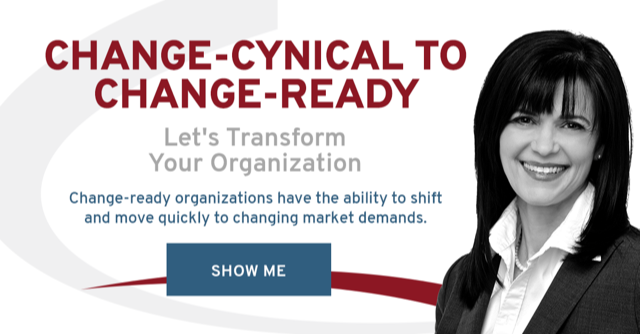Is training one of the first things you think about when launching a change in your organization? If you said yes, you’re not alone. A training program to effect change intuitively makes sense – teach people how to do the new activity (use the new software, make sales calls etc.) and they will do it. However, training is not enough to ensure your employees will stick with the new activity and make it become the normal activity.
Leaders who expect training to carry the people side of any change are often disappointed and frustrated when the training fails to deliver the expected results. In 2015 it was estimated companies in the United States spent $356 billion globally on training and didn’t get a return on that investment.
One reason for training to fail is anxiety.
The role of anxiety in learning
Have you ever experienced anxiety when it comes to training or learning something new? If you have, you’re not alone. Most of us have experienced some form anxiety. The anxiety may be caused by the fear of being left behind as new people and technologies are introduced into the organization. Or, it may be due to that feeling of being less competent or productive as we learn to do a well-established task in a new or different way.
This anxiety we feel is normal and is a result of our brain trying to maintain the consistency and predictability it needs to keep us safe.
Dr. Edgar Schein, professor emeritus at MIT Sloan School of Management, identified two types of anxiety when it comes to learning and unlearning. One he called survival anxiety and the other learning anxiety.
Survival anxiety arises when we realize that, unless we learn how to use the new technology, process, role or any other activity, we will be at a disadvantage compared to others.
 Learning anxiety arises from our perception of what the learning requires of us. It may arise when learning the new activity is more difficult than anticipated. It can also arise as we feel that sense of incompetence when learning something new. Statements like, “I used to be productive, now I can barely get anything done” or “I used to be good at my job, but now I it seems I can’t even answer a basic question” are signs of learning anxiety.
Learning anxiety arises from our perception of what the learning requires of us. It may arise when learning the new activity is more difficult than anticipated. It can also arise as we feel that sense of incompetence when learning something new. Statements like, “I used to be productive, now I can barely get anything done” or “I used to be good at my job, but now I it seems I can’t even answer a basic question” are signs of learning anxiety.
Both types of anxiety play a productive and destructive role in our learning. For example, survival anxiety can provide an initial incentive for us to learn something new, like learning new management skills to get a new job or promotion you want. Alternatively, each type of anxiety can also trigger our brain’s threat response — typically called our flight or fight response. For example, learning anxiety is increased when employees are not prepared for the training.
Regardless of which anxiety triggers the threat response, the result is similar — decreased learning. That’s why for your training programs to enable real change, it’s helpful to consider three things.
Reducing anxiety to enable new learning
- Provide and ensure context and benefit of the training is understood
One of the things that differentiates training that sticks from training that doesn’t is how prepared the people who will take the training feel. Research has shown that when people are not adequately prepared for the change before training, the result is denial and resistance.
Preparing people for training is more than informing them about the schedule, location and nature of the training. Before they receive that information, they need an understanding of the context, expectations, and the time and space to internalize what the new activities will mean for them.

Ensuring people have an understanding of the context and expectations helps build a sense of safety, because it provides a level of predictability. This doesn’t mean you need to guarantee things that you can’t, like employment or role stability. Instead, it means creating a sense of predictability and framing where the training fits within the larger context of the organization, their role, the specific change initiative, and for expectations before, during, and after the training.
Neuroscience has now confirmed what Abraham Maslow said almost 50 years ago: when the choice is between safety and growth, we choose safety.
- Raise perceived capability
Survival anxiety may motivate you to get started but decreasing the learning anxiety will ensure your employees learn the new activities and skills from the training.
One way to lower learning anxiety is to raise perceived capability. Perceived capability is our perception of our ability to be successful with any activity.
 Perceived capability is the pre-cursor to every action we take. It’s like a personal success filter. Every new activity or skill we are asked or want to learn is passed through this filter. Your perceived capability filter makes an assessment about your likelihood of success. If it determines a high-perceived capability, you likely proceed to take action and will persist through it even when it becomes difficult. However, if the filter determines a low perceived-capability, you likely won’t take any action toward the activity. For example, when my husband invited me to go sky diving a few years ago, my low perceived capability kept me far away from the activity. He on the other hand had a once in a lifetime experience.
Perceived capability is the pre-cursor to every action we take. It’s like a personal success filter. Every new activity or skill we are asked or want to learn is passed through this filter. Your perceived capability filter makes an assessment about your likelihood of success. If it determines a high-perceived capability, you likely proceed to take action and will persist through it even when it becomes difficult. However, if the filter determines a low perceived-capability, you likely won’t take any action toward the activity. For example, when my husband invited me to go sky diving a few years ago, my low perceived capability kept me far away from the activity. He on the other hand had a once in a lifetime experience.
Raising perceived capability takes time. For your formal training program to be effective at influencing performance, supporting behaviour change, and delivering results, it needs to come after your employees have received the time, opportunity, and support to try out the new activity. This means giving them the chance to explore its context, problem solve, and build their perceived capability to engage in the activity.[1]
- Recognize that although training can be mandated, learning is a choice
For me, the recognition that all learning is a choice was a light bulb moment. I was completing my master’s in education and one of the assignments was to design a program and include the learning objectives. As is typical for most learning objectives I began with “you will learn…” When I got the assignment back, my professor had written in bold letters, “You can’t know what they will learn, you can only know what you will teach them.” To this day, I avoid, as much as possible, writing learning objectives that state what another person will learn. Instead I create objectives that reflect what I want to share with the participants and what they will do during the course.
New research in neuroscience and neuroplasticity is reinforcing what my professor taught me over two decades ago. All learning is self-directed. Dr. David Rock notes in his book Your Brain at Work, when we sense someone is trying to change us it often creates an automatic threat response in the brain. Therefore, when we learn and create real change it is because we have chosen to do so in our own brain.[2]
Training is necessary, but not sufficient, to enable change
Training is an important and necessary component of any change initiative. Making the time to understand the anxiety we all experience when it comes to learning will help you design and deliver training that will lead to real change.
In an upcoming blog post I will share insights on why unlearning matters and what happens during unlearning. You will also explore what you can do, as a leader, to encourage unlearning and new learning to enable real and healthy organizational change.
[1] Carnell, C. (2007) Managing Change In Organizations
[2] Rock, D. (2009). Your Brain at Work. New York Harper Business












Leave a Reply
Want to join the discussion?Feel free to contribute!